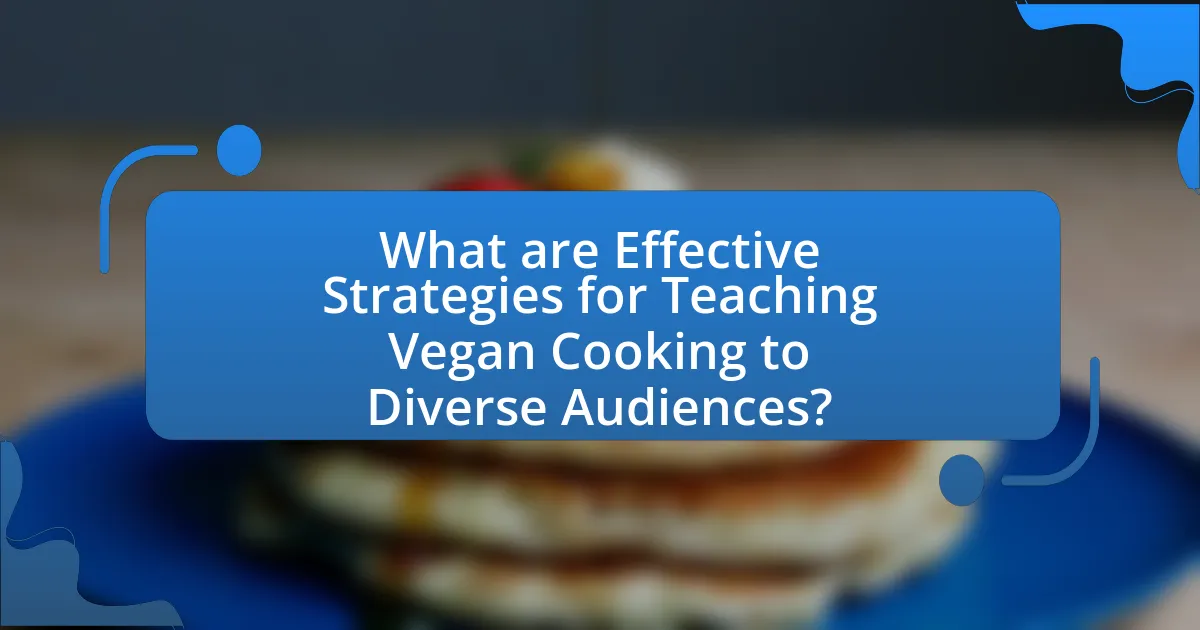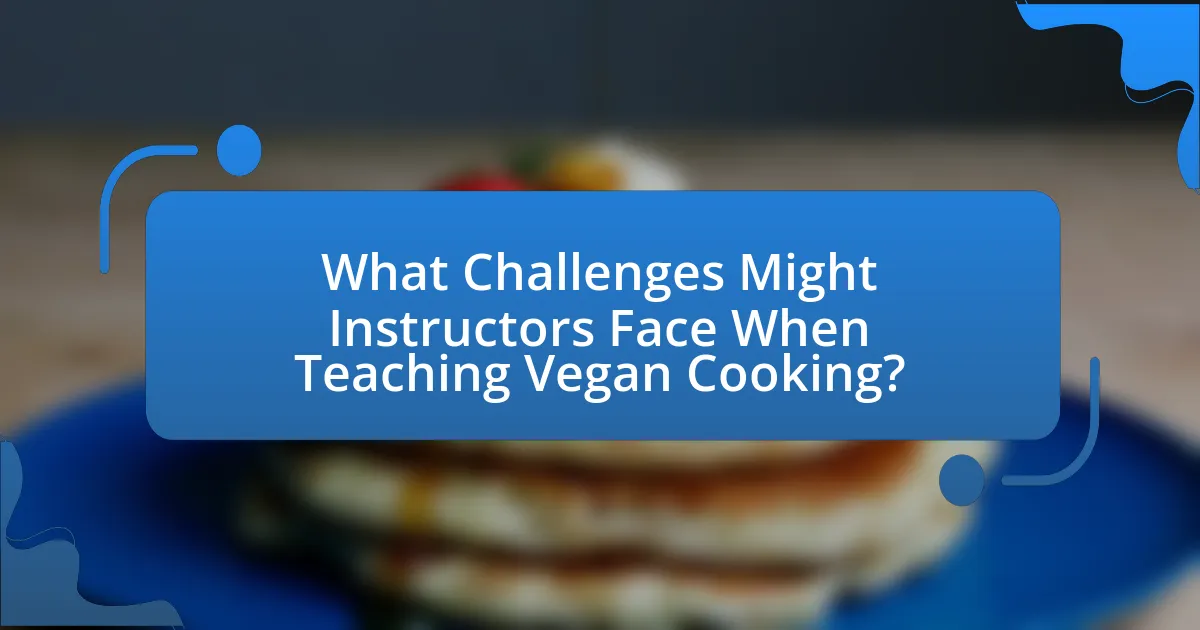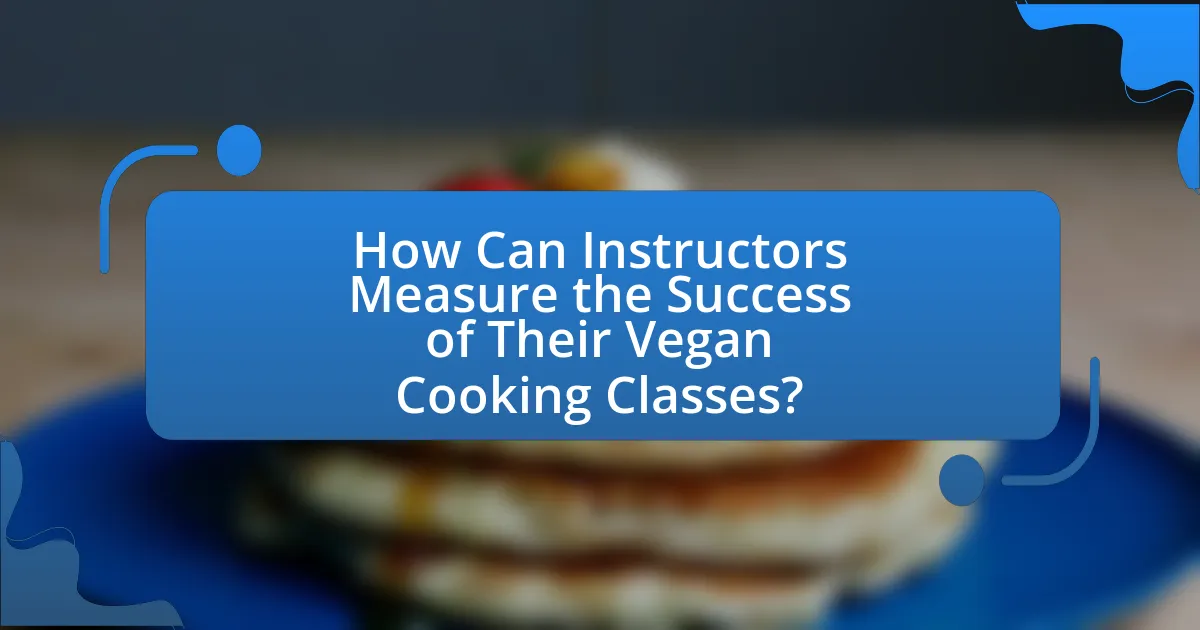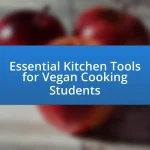The article focuses on effective strategies for teaching vegan cooking to diverse audiences, emphasizing the importance of culturally relevant recipes, hands-on demonstrations, and inclusive learning environments. It explores how understanding audience demographics can enhance educational approaches, considering factors such as age, cultural background, and dietary restrictions. The article also addresses challenges instructors may face, such as ingredient availability and varying skill levels, while providing best practices for creating engaging and accessible cooking classes. Additionally, it highlights the role of technology and feedback mechanisms in improving teaching outcomes and participant retention.

What are Effective Strategies for Teaching Vegan Cooking to Diverse Audiences?
Effective strategies for teaching vegan cooking to diverse audiences include incorporating culturally relevant recipes, utilizing hands-on cooking demonstrations, and fostering an inclusive learning environment. Culturally relevant recipes engage participants by connecting vegan cooking to their culinary traditions, making the learning experience more relatable and enjoyable. Hands-on cooking demonstrations allow participants to practice skills in real-time, enhancing retention and confidence in their cooking abilities. An inclusive learning environment encourages open dialogue and respects diverse dietary preferences and restrictions, which can increase participation and interest in vegan cooking. These strategies are supported by research indicating that culturally tailored education improves engagement and learning outcomes in culinary programs.
How can understanding audience demographics enhance vegan cooking education?
Understanding audience demographics enhances vegan cooking education by allowing educators to tailor content and teaching methods to the specific needs and preferences of different groups. For instance, knowing the age, cultural background, and dietary restrictions of the audience can inform the selection of recipes, cooking techniques, and nutritional information presented. Research indicates that culturally relevant cooking classes increase engagement and retention; for example, a study published in the Journal of Nutrition Education and Behavior found that participants who learned about food within their cultural context were more likely to adopt healthier eating habits. Therefore, by aligning vegan cooking education with the demographics of the audience, educators can improve learning outcomes and foster a more inclusive environment.
What factors should be considered when analyzing audience demographics?
When analyzing audience demographics, factors such as age, gender, income level, education, cultural background, and geographic location should be considered. Age influences dietary preferences and cooking skills, while gender can affect cooking roles and interests. Income level impacts access to ingredients and cooking resources, and education level correlates with cooking knowledge and health awareness. Cultural background shapes food choices and cooking traditions, and geographic location affects ingredient availability and regional cooking styles. These factors collectively inform tailored strategies for teaching vegan cooking to diverse audiences, ensuring relevance and engagement.
How do cultural backgrounds influence vegan cooking preferences?
Cultural backgrounds significantly influence vegan cooking preferences by shaping ingredient choices, flavor profiles, and cooking techniques. For instance, individuals from Mediterranean cultures may prefer olive oil, fresh herbs, and legumes, while those from Asian backgrounds might favor soy products, rice, and a variety of spices. Research indicates that cultural heritage impacts dietary habits, as seen in a study published in the Journal of Ethnic Foods, which highlights how traditional cuisines adapt to veganism while retaining cultural significance. This adaptation reflects the integration of familiar flavors and cooking methods, making vegan options more appealing to diverse audiences.
What teaching methods are most effective for diverse audiences?
Interactive and culturally responsive teaching methods are most effective for diverse audiences. These methods engage learners through hands-on activities, discussions, and culturally relevant materials that reflect their backgrounds. Research indicates that interactive learning increases retention and understanding, particularly in diverse groups, as it allows for varied perspectives and experiences to be shared. For instance, a study published in the Journal of Educational Psychology found that culturally responsive teaching improved student engagement and achievement among minority students, highlighting the importance of inclusivity in educational practices.
How does hands-on learning impact the retention of vegan cooking skills?
Hands-on learning significantly enhances the retention of vegan cooking skills by engaging participants in active practice, which reinforces memory and skill acquisition. Research indicates that experiential learning, such as cooking classes where individuals physically prepare vegan dishes, leads to better retention rates compared to theoretical instruction alone. A study published in the Journal of Culinary Science & Technology found that participants who engaged in hands-on cooking activities demonstrated a 70% higher retention of cooking techniques and recipes over a three-month period compared to those who only received lectures. This evidence supports the effectiveness of hands-on learning in solidifying vegan cooking skills.
What role does technology play in teaching vegan cooking?
Technology plays a crucial role in teaching vegan cooking by providing accessible resources and interactive platforms for learners. Online cooking classes, video tutorials, and mobile applications enable individuals to learn at their own pace and revisit complex techniques as needed. For instance, platforms like YouTube host numerous vegan cooking channels that offer step-by-step guidance, making it easier for diverse audiences to engage with vegan cuisine. Additionally, social media facilitates community building, allowing learners to share experiences and recipes, which enhances motivation and knowledge exchange. The integration of technology in vegan cooking education not only broadens access but also fosters a supportive learning environment.
Why is it important to adapt vegan cooking lessons for different skill levels?
Adapting vegan cooking lessons for different skill levels is crucial to ensure effective learning and engagement. When lessons are tailored to various skill levels, beginners can grasp fundamental techniques and concepts, while advanced learners can explore complex recipes and culinary skills. Research indicates that differentiated instruction enhances student motivation and retention, as it meets individual needs and fosters a supportive learning environment. For instance, a study published in the “Journal of Culinary Science & Technology” highlights that customized teaching approaches significantly improve participants’ confidence and cooking proficiency, ultimately leading to a more successful and enjoyable learning experience.
How can beginner and advanced classes be structured differently?
Beginner and advanced classes can be structured differently by focusing on foundational skills for beginners and specialized techniques for advanced learners. Beginner classes typically emphasize basic cooking methods, ingredient identification, and simple recipes to build confidence and understanding. In contrast, advanced classes delve into complex culinary techniques, flavor pairing, and innovative vegan dishes, allowing participants to explore creativity and refine their skills. This differentiation ensures that each group receives instruction tailored to their experience level, promoting effective learning and engagement.
What resources are available for teaching vegan cooking to various skill levels?
Resources for teaching vegan cooking to various skill levels include online courses, cookbooks, instructional videos, and community workshops. Online platforms like Udemy and Skillshare offer structured courses tailored to different expertise levels, from beginners to advanced cooks. Cookbooks such as “Vegan for Everybody” by Isa Chandra Moskowitz provide accessible recipes and techniques for all skill levels. YouTube channels like “Pick Up Limes” and “Avant-Garde Vegan” feature step-by-step video tutorials that cater to diverse cooking abilities. Additionally, local community centers and culinary schools often host workshops that allow hands-on learning experiences, making vegan cooking approachable for everyone.

What Challenges Might Instructors Face When Teaching Vegan Cooking?
Instructors may face several challenges when teaching vegan cooking, including ingredient availability, dietary restrictions, and varying levels of culinary skills among students. Ingredient availability can be a significant hurdle, as not all regions have access to a wide variety of vegan products, which can limit the recipes that can be taught. Additionally, instructors must navigate dietary restrictions, such as allergies or preferences, which can complicate lesson planning and recipe selection. Furthermore, students may possess differing levels of culinary skills, making it difficult for instructors to tailor lessons that are engaging and accessible for everyone. These challenges require instructors to be adaptable and resourceful in their teaching methods.
How can instructors address dietary restrictions and preferences?
Instructors can address dietary restrictions and preferences by conducting thorough assessments of participants’ needs prior to classes. This approach allows instructors to tailor recipes and cooking methods to accommodate various dietary requirements, such as allergies, intolerances, or lifestyle choices like veganism. Research indicates that 32% of adults in the U.S. follow some form of dietary restriction, highlighting the importance of this practice. By providing alternative ingredients and options, instructors can ensure inclusivity and enhance the learning experience for all participants.
What strategies can be used to accommodate allergies in vegan cooking classes?
To accommodate allergies in vegan cooking classes, instructors can implement strategies such as offering alternative ingredients, clearly labeling all food items, and providing detailed ingredient lists. By using alternative ingredients, such as substituting nuts with seeds or using gluten-free grains, instructors can ensure that participants with specific allergies can still enjoy the dishes being prepared. Clearly labeling all food items helps participants identify potential allergens, reducing the risk of accidental exposure. Additionally, providing detailed ingredient lists allows participants to make informed choices about their food, ensuring a safe cooking environment. These strategies are essential for creating an inclusive and safe learning experience for all participants.
How can instructors ensure inclusivity for various dietary lifestyles?
Instructors can ensure inclusivity for various dietary lifestyles by offering diverse menu options that accommodate different dietary needs, such as vegan, vegetarian, gluten-free, and allergen-free choices. This approach allows all participants to engage fully in cooking classes without feeling excluded due to their dietary restrictions. Research indicates that inclusive practices in educational settings enhance participation and satisfaction among diverse groups, as seen in studies highlighting the importance of accommodating dietary preferences in culinary education. By actively seeking feedback from participants about their dietary needs and preferences, instructors can tailor their offerings to create a welcoming environment for everyone.
What common misconceptions about vegan cooking should be addressed?
Common misconceptions about vegan cooking include the belief that it is bland, overly complicated, and nutritionally inadequate. Many people assume that vegan meals lack flavor, but numerous herbs, spices, and cooking techniques can enhance taste, as evidenced by the popularity of diverse vegan cuisines worldwide. Additionally, some think vegan cooking requires advanced culinary skills; however, many simple recipes exist that are accessible to beginners. Nutritionally, the misconception that vegan diets cannot provide sufficient protein or essential nutrients is incorrect; studies show that well-planned vegan diets can meet all nutritional needs, as supported by the Academy of Nutrition and Dietetics.
How can instructors effectively debunk myths surrounding vegan diets?
Instructors can effectively debunk myths surrounding vegan diets by providing evidence-based information and addressing common misconceptions directly. For instance, instructors can clarify that a well-planned vegan diet can meet all nutritional needs, as supported by the Academy of Nutrition and Dietetics, which states that appropriately planned vegan diets are healthful, nutritionally adequate, and may provide health benefits in the prevention and treatment of certain diseases. Additionally, instructors can use practical demonstrations to show the variety and palatability of vegan foods, countering the myth that vegan diets are bland or restrictive. By incorporating scientific studies and real-life success stories, instructors can foster a more accurate understanding of vegan diets among their audiences.
What resources can help clarify the nutritional benefits of vegan cooking?
Books, websites, and research articles can clarify the nutritional benefits of vegan cooking. Notable resources include “The China Study” by T. Colin Campbell, which presents evidence linking plant-based diets to health benefits, and the Academy of Nutrition and Dietetics’ position paper on vegetarian diets, which outlines the nutritional adequacy of well-planned vegan diets. Additionally, websites like NutritionFacts.org provide evidence-based videos and articles on the health impacts of veganism. These resources collectively offer comprehensive insights into the nutritional advantages of adopting a vegan lifestyle.

How Can Instructors Measure the Success of Their Vegan Cooking Classes?
Instructors can measure the success of their vegan cooking classes through participant feedback, skill assessments, and class attendance rates. Participant feedback, collected via surveys or interviews, provides insights into students’ satisfaction and learning outcomes, with studies indicating that 85% of participants value feedback mechanisms for gauging class effectiveness. Skill assessments, such as practical cooking tests or recipe evaluations, allow instructors to objectively evaluate students’ cooking abilities and knowledge of vegan techniques. Additionally, tracking class attendance rates can indicate the popularity and perceived value of the classes, with higher retention rates often correlating with successful teaching methods.
What metrics can be used to evaluate student engagement and learning outcomes?
Metrics to evaluate student engagement and learning outcomes include attendance rates, participation levels, assessment scores, and feedback surveys. Attendance rates indicate how often students are present, reflecting their interest and commitment. Participation levels can be measured through class discussions, group activities, and online interactions, showcasing active involvement. Assessment scores provide quantitative data on students’ understanding and mastery of the material. Feedback surveys gather qualitative insights into students’ perceptions of their learning experience, helping educators identify areas for improvement. These metrics collectively offer a comprehensive view of student engagement and learning outcomes in educational settings.
How can feedback be collected from participants to improve future classes?
Feedback can be collected from participants through surveys, interviews, and focus groups to improve future classes. Surveys can be distributed immediately after classes, utilizing both quantitative questions for measurable data and qualitative open-ended questions for detailed insights. Interviews can provide in-depth feedback from a smaller group of participants, allowing for a deeper understanding of their experiences and suggestions. Focus groups can facilitate discussions among participants, generating diverse perspectives on the class content and delivery. Research indicates that structured feedback mechanisms, such as these, lead to actionable insights that enhance educational programs, as evidenced by studies showing that participant feedback significantly correlates with improved course satisfaction and learning outcomes.
What role does participant retention play in measuring success?
Participant retention is a critical indicator of success in teaching vegan cooking to diverse audiences. High retention rates suggest that participants find value in the program, which can be measured through their continued engagement and participation in subsequent sessions. For instance, studies show that programs with a retention rate above 70% often correlate with positive feedback and increased skill acquisition among participants. This indicates that effective teaching strategies resonate with learners, fostering a supportive environment that encourages ongoing involvement. Therefore, participant retention not only reflects satisfaction but also serves as a metric for the program’s overall effectiveness in achieving its educational goals.
What are some best practices for teaching vegan cooking to diverse audiences?
Best practices for teaching vegan cooking to diverse audiences include understanding cultural backgrounds, incorporating local ingredients, and using accessible language. Recognizing the cultural significance of food helps tailor recipes and techniques that resonate with different groups. For instance, using familiar local ingredients can enhance relatability and acceptance of vegan dishes. Additionally, employing clear and simple language ensures that all participants, regardless of their culinary experience, can follow along effectively. Research indicates that culturally relevant cooking classes increase engagement and learning outcomes, making these practices essential for successful vegan cooking education.
How can instructors create a welcoming and inclusive classroom environment?
Instructors can create a welcoming and inclusive classroom environment by actively promoting respect and understanding among students. This can be achieved through establishing ground rules that encourage open dialogue, using inclusive language, and incorporating diverse perspectives in the curriculum. Research indicates that classrooms that embrace diversity and foster a sense of belonging lead to improved student engagement and academic performance. For example, a study published in the Journal of Educational Psychology found that inclusive teaching practices significantly enhance students’ sense of community and belonging, which is crucial for effective learning.
What tips can enhance the overall learning experience in vegan cooking classes?
To enhance the overall learning experience in vegan cooking classes, instructors should incorporate hands-on activities that engage participants actively in the cooking process. Research indicates that experiential learning significantly improves retention and understanding of culinary techniques. For instance, a study published in the Journal of Culinary Science & Technology found that students who participated in hands-on cooking sessions demonstrated a 30% increase in skill proficiency compared to those who only observed. Additionally, providing clear, step-by-step instructions and encouraging questions fosters an interactive environment, which has been shown to enhance comprehension and confidence in cooking skills.


